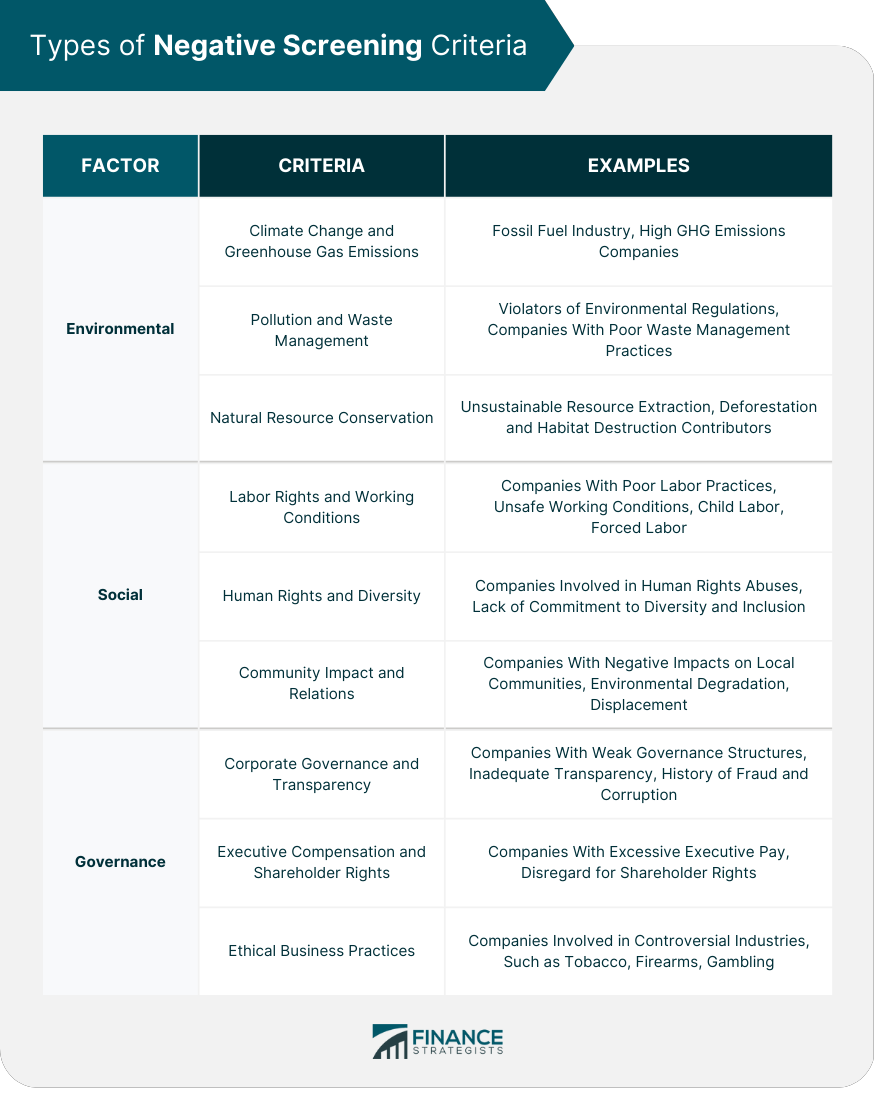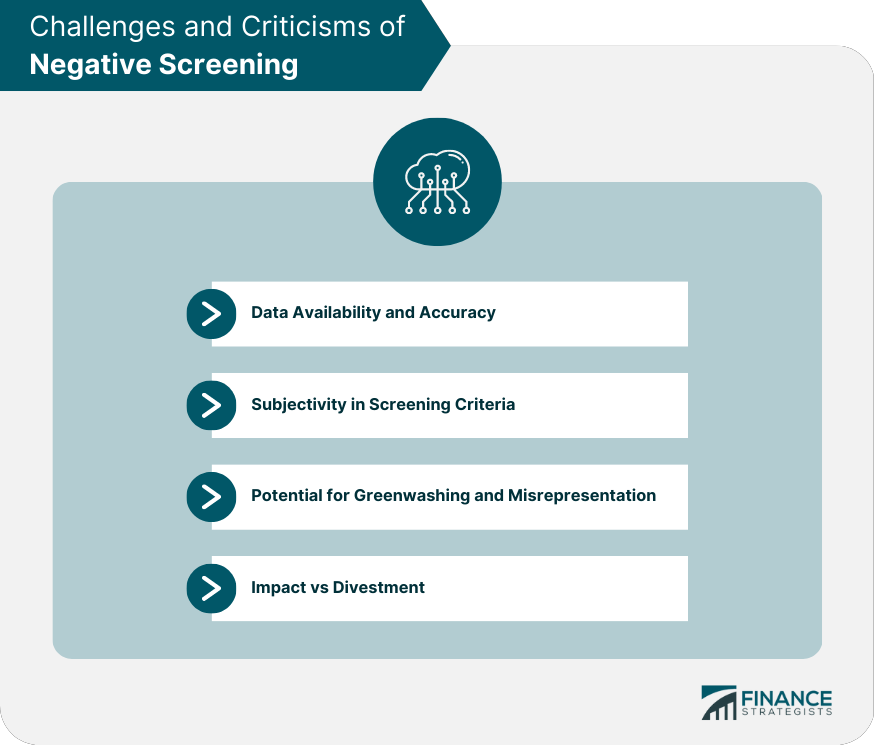Negative screening is a process used in investing to eliminate certain types of companies or industries from consideration based on specific criteria, such as ethical or social reasons. This process involves identifying and excluding companies that engage in practices that are deemed unacceptable by investors. The criteria used for negative screening can vary, but common examples include companies involved in tobacco, weapons, or gambling. Negative screening can work in different ways, depending on the specific investment strategy and criteria being used. For example, some investors may use negative screening to create a "socially responsible" portfolio by excluding companies that have poor environmental or labor practices. Other investors may use negative screening to avoid investing in industries that are considered to have a high risk of regulatory or legal challenges, such as fossil fuels or tobacco. Climate Change and Greenhouse Gas Emissions: Investors may choose to exclude companies with significant contributions to climate change, such as those in the fossil fuel industry or with high greenhouse gas emissions. Pollution and Waste Management: Companies that produce excessive pollution, fail to manage waste effectively, or violate environmental regulations may be screened out. Natural Resource Conservation: Investors may avoid businesses that engage in unsustainable resource extraction or contribute to deforestation and habitat destruction. Labor Rights and Working Conditions: Companies with poor labor practices, such as child labor, forced labor, or unsafe working conditions, may be excluded from portfolios. Human Rights and Diversity: Investors may screen out businesses involved in human rights abuses or those that lack commitment to diversity and inclusion. Community Impact and Relations: Companies that have negative impacts on local communities, such as through displacement or environmental degradation, may be subject to negative screening. Corporate Governance and Transparency: Investors might avoid firms with weak corporate governance structures, inadequate transparency, or a history of fraud and corruption. Executive Compensation and Shareholder Rights: Companies with excessive executive pay or a disregard for shareholder rights may be excluded. Ethical Business Practices: Businesses involved in controversial industries, such as tobacco, firearms, or gambling, may be subject to negative screening. Investors must first define the criteria for exclusion, which may be based on their personal values or investment objectives. These criteria should be clear and measurable to ensure effective implementation. Internal Research: Investors or portfolio managers may conduct their research to gather information on companies and sectors to be excluded based on the established criteria. External Research Providers: Third-party ESG research providers can supply data and analysis to support the negative screening process. Collaboration with NGOs and Other Stakeholders: Engaging with non-governmental organizations (NGOs) and other stakeholders can help investors access valuable insights and perspectives on ESG issues. Integrating Negative Screening with Other Investment Strategies: Investors should consider how negative screening will interact with other investment approaches, such as positive screening or active engagement. Monitoring and Updating the Exclusion List: The list of excluded companies or sectors should be regularly reviewed and updated based on new information or changes in criteria. Assessing the Impact on Portfolio Risk and Return: Investors should analyze the potential effects of negative screening on portfolio diversification and performance. Accessing reliable and comprehensive ESG data can be challenging, as companies may not disclose relevant information or provide inconsistent reporting. Determining exclusion criteria can be subjective, with different investors holding different values and priorities. Companies may engage in greenwashing, or the practice of presenting themselves as environmentally responsible, without making substantive changes to their operations. Some critics argue that negative screening may not lead to significant change in corporate behavior, and that active engagement with companies may be more effective in promoting ESG improvements. Negative screening is an important strategy in the responsible investing landscape, allowing investors to align their portfolios with their values and potentially reduce exposure to ESG-related risks. While the approach faces challenges, such as data availability and subjectivity in screening criteria, ongoing research, technological advancements, and collaboration among stakeholders can help refine negative screening practices and enhance their impact. As investors continue to prioritize ESG issues, negative screening will likely remain a key component of responsible investment strategies.What Is Negative Screening?
Types of Negative Screening Criteria
Environmental Factors
Social Factors
Governance Factors

Implementation of Negative Screening
Establishing Exclusion Criteria
Research and Data Collection Methods
Portfolio Construction and Management
Challenges and Criticisms of Negative Screening
Data Availability and Accuracy
Subjectivity in Screening Criteria
Potential for Greenwashing and Misrepresentation
Impact vs Divestment

Conclusion
Negative Screening FAQs
Negative screening in investing is the process of eliminating certain types of companies or industries from consideration for investment based on specific criteria, such as ethical or social reasons. For example, an investor might use negative screening to exclude companies that engage in environmentally harmful practices.
In social responsibility investing, negative screening is used to exclude companies that do not meet certain ethical or social criteria. For example, investors might exclude companies that engage in animal testing or have poor labor practices. Negative screening allows investors to align their investments with their values.
One drawback of negative screening is that it can limit investment opportunities and potentially reduce returns. Additionally, negative screening criteria can be subjective and may vary depending on individual investors' values and beliefs. As a result, negative screening can be challenging to implement consistently across all investment portfolios.
Yes, negative screening can be used in other industries, such as hiring or procurement. For example, a company might use negative screening to exclude suppliers that have poor labor practices or do not meet environmental standards.
Negative screening involves the exclusion of certain companies or industries from consideration for investment, while positive screening involves the selection of companies that meet specific criteria. For example, positive screening might involve selecting companies that have strong environmental or social practices.
True Tamplin is a published author, public speaker, CEO of UpDigital, and founder of Finance Strategists.
True is a Certified Educator in Personal Finance (CEPF®), author of The Handy Financial Ratios Guide, a member of the Society for Advancing Business Editing and Writing, contributes to his financial education site, Finance Strategists, and has spoken to various financial communities such as the CFA Institute, as well as university students like his Alma mater, Biola University, where he received a bachelor of science in business and data analytics.
To learn more about True, visit his personal website or view his author profiles on Amazon, Nasdaq and Forbes.















